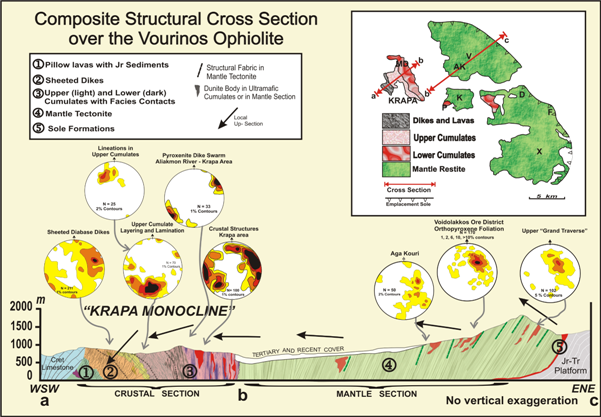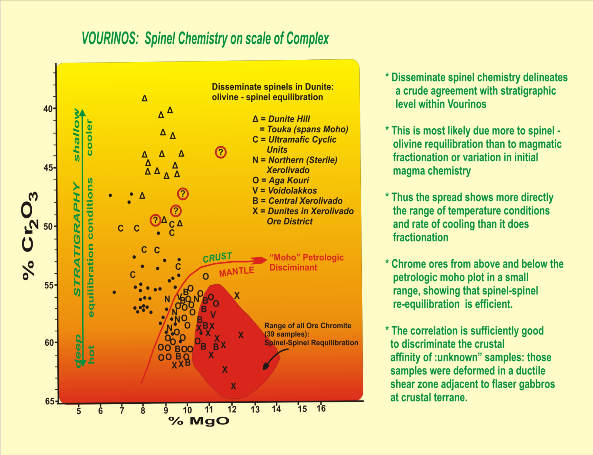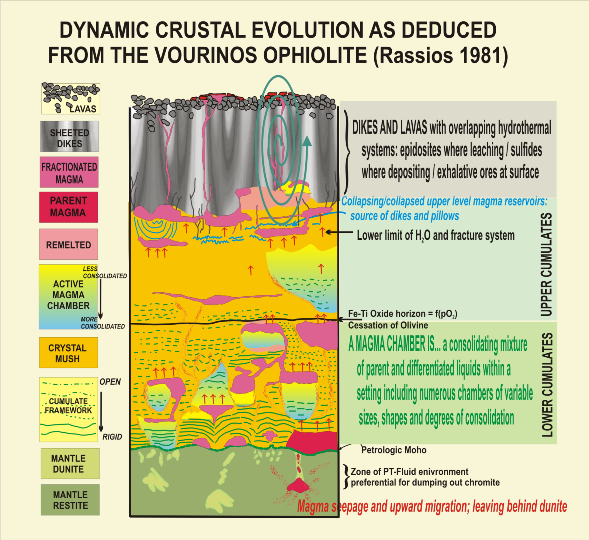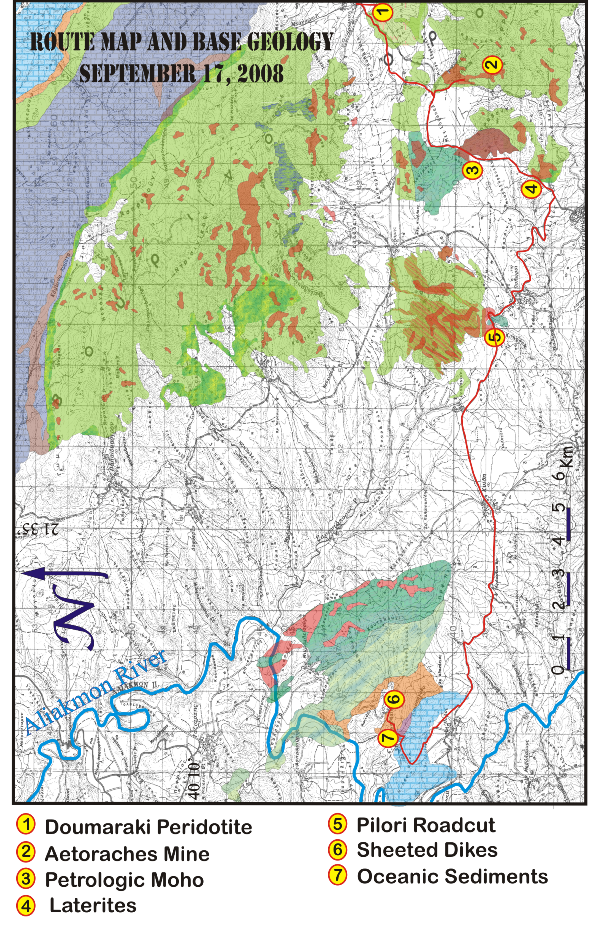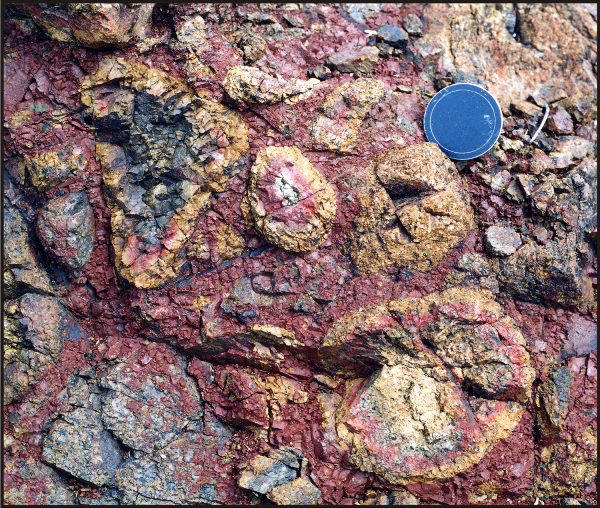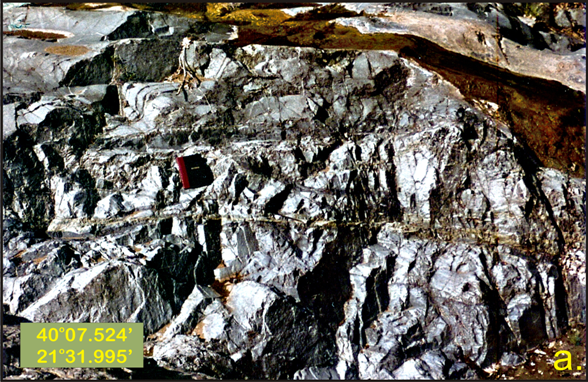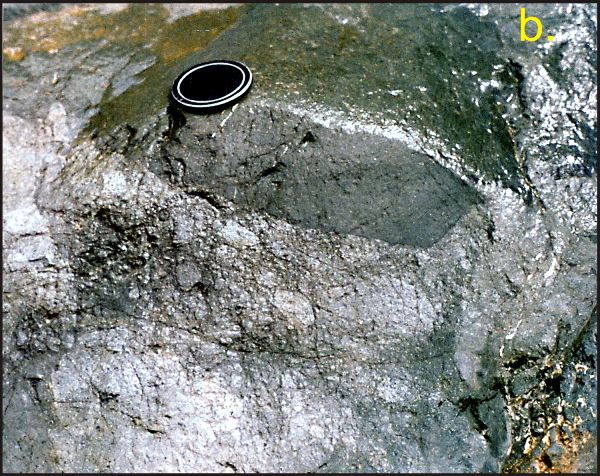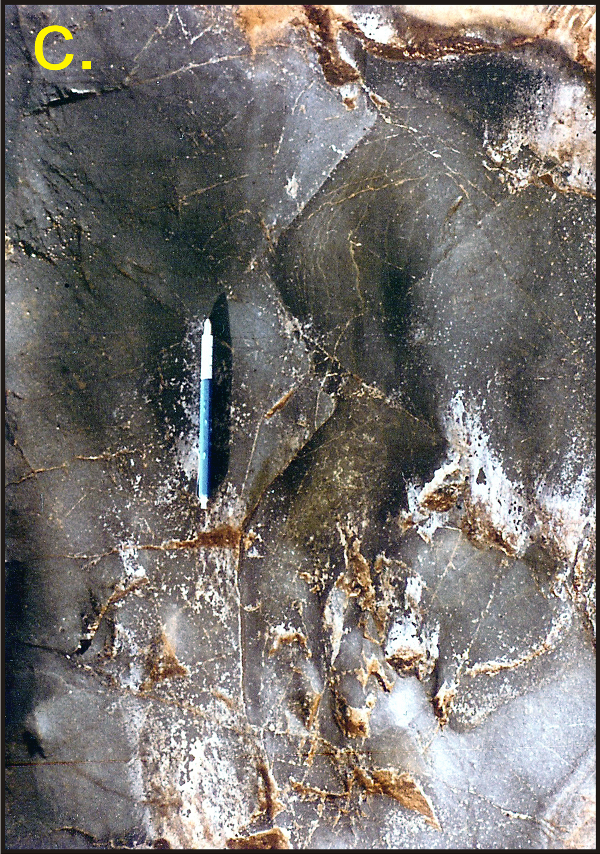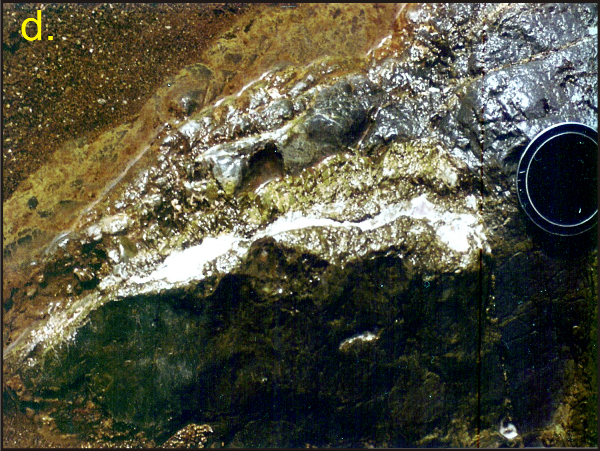Day 3 -THE VOURINOS OPHIOLITE
The Vourinos ophiolite is an essentially unbroken remnant of oceanic lithosphere, intact from amphibolite sole at its base to deep water sediments at its top: this section is about 12 km thick, and oriented approximately vertically today, with uppermost rocks to the west. Vourinos highly influenced the Penrose Conference definition of an ophiolite, and its bias still dominates “idealized” models of ocean lithosphere. Our field symposium intends to display both the classic ophiolitic section and demonstrate its bias on interpretation of oceanic section.
The section traversed today begins in unserpentinized harzburgite restite that retains a high-temperature mantle fabric: this fabric is seen as a weak shape-defined planar orientation of blocky-shaped orthopyroxene in a matrix of olivine grains of relatively large (~0.5 cm) grain size. Both minerals show an abundance of dislocation lamellae, kinking, and twinning, observable through a hand lens. In universal stage analyses, the planar fabric proves to be a strong intragranular deformation, referred to as a “diapiric” or simply as mantle fabric. The mineral orientation is presumed to form after partial melting by mantle flow or upwelling beneath a spreading center, and originates at temperatures of 1200ºC to 900ºC at 100 to 40 km. To unravel the “ophiolitic bias” from ocean lithospheric models based on these kinds of fabric one must question how this fabric survived transport from a depth of 100 km, susceptible to further ductile deformation down to temperatures ~700ºC, without any intervening deformation imprint or rotation. The presence of brittle ramp structures are pervasive to the complex, and even if each represents an extremely minor offset, collectively they are an effective mechanism for thinning and/or rotation of lithosphere.
At relatively shallow sub-ridgecrest depths just below the petrologic moho (~1250ºC), high heat flow means that high-level mantle rocks will be among the earliest to cool below the solidus with drift away from the ridgecrest, thus freezing in ductile fabrics before significant spreading or additional ductile deformation occurs. At the Aetoraches locality, dunite hosting chrome deposits demonstrates near-pegmatitic fabric, with post-solidus crystal growth aligned to a planar imprinting ductile fabric: this fabric parallels fold planes on all scales, with original “S0” mantle fabrics highly attenuated and rotating into these fabrics. This secondary fabric is observed in dunites in the nearby cumulate dunite above the petrologic moho, but the higher-temperature tectonite mantle fabric is truncated at the moho. The petrologic moho at Vourinos was the first to be recognized, and is a sharp intrusive contact with irregular, m-scale, topography.
Lowermost cumulates and cumulates at the base of cyclic units are dunite, which then grade to wehrlite, pyroxenite and gabbronorite or troctolite. Adcumulate rocks (clinopyroxenites) examined in universal stage microscope show strong intragranular fabrics aligned with the later ductile overprint. The array of cyclic units and ultramafics document low-level magma chambers on the scale of hundreds of m3 to km3 volumes with possible up-welling structures. Further up-section, mafic cumulates tend to larger more continuous magma cells with synformal (slumping?) in-folding perpendicular to magmatic fabric. Within these structures, initial diabasic dikes intrude, increasing in proportions to form a 0.5 – 1.5 km thick sheeted dike complex (chiefly IAT with secondary boninite compositions). These sections cross low-amphibolite to greenschist facies metamorphism. Flows with zeolite facies and rare pillow lava occurrences overlie the section, but are truncated beneath an oceanic (upper Jurassic calpionellid limestone-radiolarian chert) unconformity. Hydrothermal systems cross these metamorphic facies, and in uppermost sections jaspers and metalliferous sediments have been identified. Both lavas and oceanic sediments are deeply eroded beneath the upper Cretaceous unconformity, overlain by rudistid-bearing reefy to nearly flysch-like limestone. Structures within the oceanic sediments not continuous into the Cretaceous are interpreted as probable emplacement deformation.
Stop 1: Vourinos Ophiolite - Doumaraki Peridotite
THE VOURINOS MANTLE SUITE
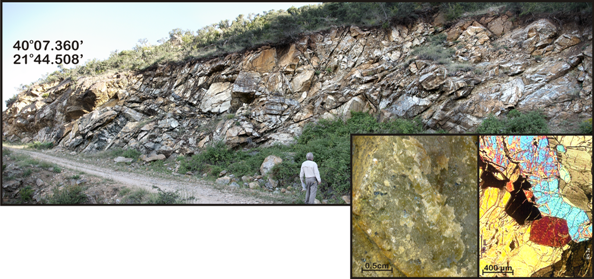
Top panorama: The mantle suite of Vourinos exposed at the Doumaraki Roadcut; Left inset: Outcrop appearance of ultra-fresh harzburgite.; Right inset: Petrographic view of harzburgite fabric.
The site is less than 200 m from the (locally covered) sole contact of Vourinos. Harzburgite with m-scale tabular dunite bodies at Doumaraki remain essentially unaltered with LOI < 1-1.5%. Blocky orthopyroxene grains (0.5 - 1 cm) and large irregular (>1 - 2 cm) dunite grains are representative of high TP (diapiric) fabric: dislocation lamellae in olivine can be discerned in hand-samples. Mineral foliation is best shown on weathered rock faces, and weak mineral lineation defined by Cr spinel. The outcrop is cut by brittle ramp structures topping approximately to the north. Consider: How did this unaltered mantle tectonite arrive at the surface with no serpentinization, and no apparent deformation imprint between high temperature ductile fabric and brittle field?
Stop 2: Vourinos Ophiolite - Aetoraches Mine
CHROME IN THE SHALLOW MANTLE
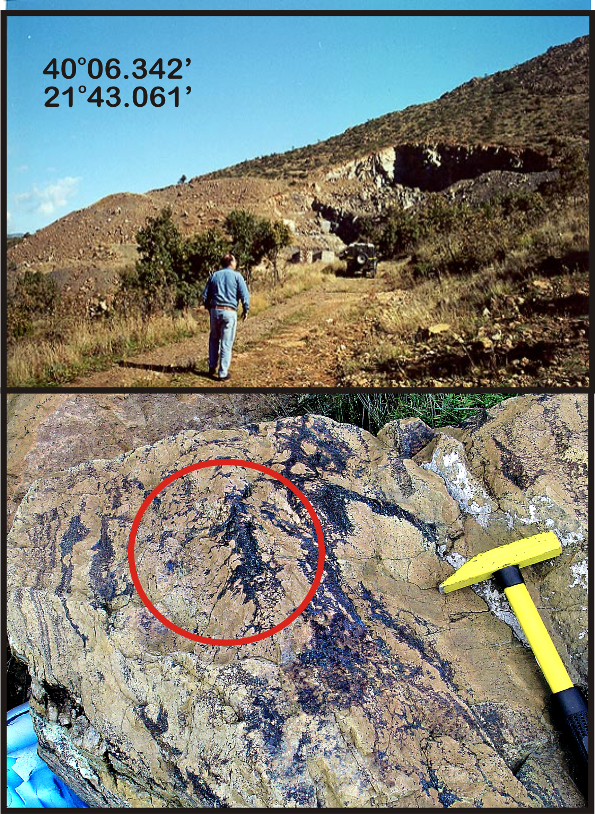
Top photo: Entrance to open-pit Aetoraches chrome mine. Lower photo: Large olivine crystals showing apparent subsolidus growth into secondary tectonic foliation.
The Aetoraches Mine produced 200,000t of chrome ore before 1992, and was a primary exploration target: geologic estimations of reserves reach 2 mt. Ores crop out within a dunite body (>1 km length) located within harzburgite tectonite several hundred meters beneath the "petrologic moho." Mapping on 1:1000 scale emphasized high-temperature mantle fabric and delineated a synformal structure of host dunite, thus allowing modelling of ore continuation. Minor folding in ore layers exposed in the mine area conform with parasitic folds of the larger structure.
The area preserves sub-spreading center fabrics synchronous to ridgecrest magmatism, overprinted by a lower-temperature ductile fabric attributed to early emplacement-oriented strain. Chrome ores include layered types, folded and schlieren type. Subsolidus growth of olivine crystals across ore layers oriented with the late- stage ductile fabric creates a rare "flowering" or crescumulate appearance to some ores.
Consider: Does subsolidus olivine growth indicate the initiation of constrictive strain?
Stop 3: Vourinos Ophiolite - Petrologic Moho
THE “PETROLOGIC MOHO”

The “petrologic moho” contact with harzburgite tectonite to left of photo, and basal ultramafic cumulate complex to right.
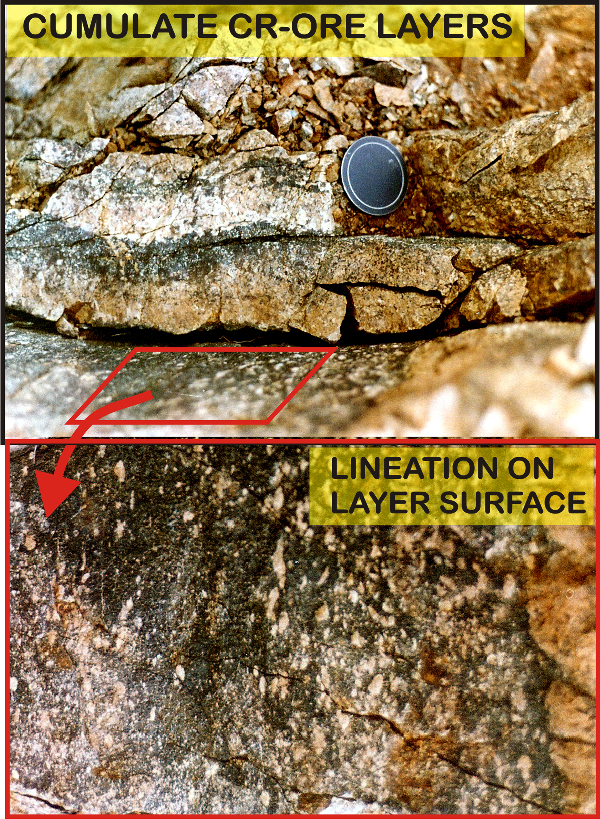
Cumulate chromite layer in basal dunite (top) and view on magmatic layering plane (bottom) demonstrating strong lineation.
The concept of a preserved contact between the oceanic mantle and crustal sequence, the petrologic moho, was first described at this locality of Vourinos. The contact between mantle harzburgite and a crustal section of cumulate dunite grading to adcumulate wehrlite, olivine clinopyroxenite, and ultimately gabbro and troctolite is sharp with m-scale intrusive topography. High-temperature intragranular deformation (diapiric fabric) is truncated at this contact, though lower temperature ductile fabric crosses the contact and is evident in folding of chrome ores, as well as strong lineations on cumulate chrome layers (photos). The basal dunite to “beheaded” top of the first cyclic cumulate unit is ~650m thick, overlain by multilithologic cyclic units (dunite to wehrlite to olivine clinopyroxenite to clinopyroxenite) ultimately evolving to a gabbro-troctolite sequence ~1.5 km above the “moho.” Folds in Cr-ore occurrences within the basal dunite and lineations in adcumulate pyroxenites (optically defined) demonstrate a subsolidus fabric with 020 - 040 planar orientation.
Stop 4: Vourinos Ophiolite – Laterites
LATERITES ABOVE HARZBURGITE

Lateritic surface and redeposited laterite-rich sediments on serpentinized mantle harzburgite. The black layer is sedimentary serpentine.
Ni-laterites form from erosion of ultramafic rocks via leaching of mobile constituents, leaving behind resistant elements such as Ni, Fe and Si. These red layers, grading 0.5 - 1.5% NiO occur in situ above a Ni-rich weathering crust and eroded harzburgite. These mark the local base of Mesohellenic sedimentation. A gradation from constrictive structures upwards into Tertiary sediments and extensional jointing apparently transcends the compressive/extensional environment. A hydrothermal chimney crops out in harzburgite near the laterites, and has been suggested to be a late oceanic artifact. Serpentine cobbles with silicified rinds occur south of the laterites. Only peridotite cobbles occur in this conglomerate, though elsewhere other ophiolitic material is found; they do not include Pelagonian or Cretaceous material,found as clasts in the lowermost Tertiary. Possibly, the serpentine conglomerates belong to the oceanic period.
Consider: How much harzburgite (~0.2 - 0.4% NiO) must be eroded to produce a Ni-laterite (~1 - 2% NiO)?
Stop 5: Vourinos Ophiolite - Pilori Roadcut
ULTRAMARIC CUMULATES
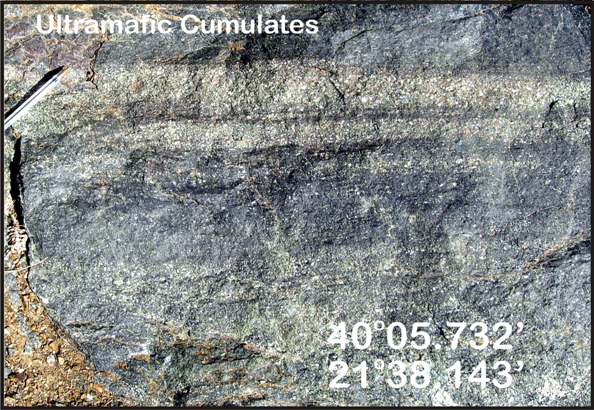
Magmatic layering in ultramafic cumulates (dunite-wehrlite-olivine clinopyroxenite).
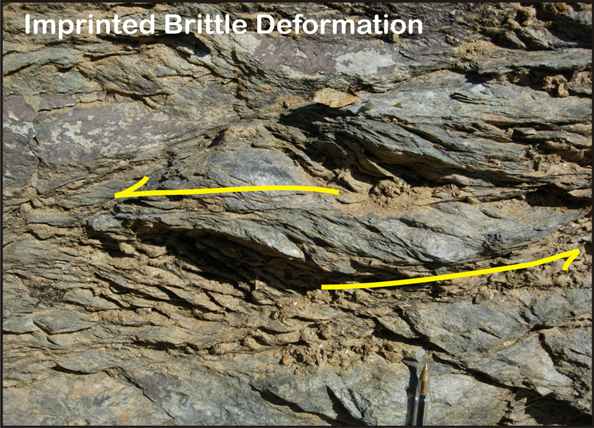
Brittle structures imprinted on ultramafic section showing topping directions to the WSW.
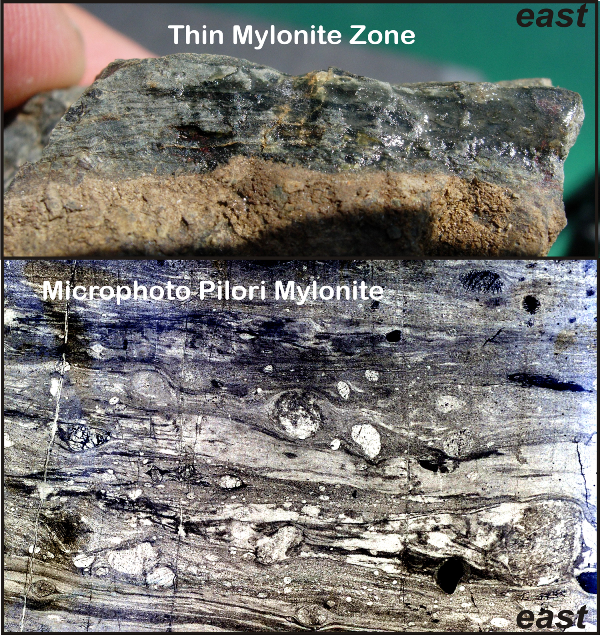
Top photo in panel -- Outcrop appearance of thin mylonite zone in ultramafic cumulates. Lower photo in panel – appearance of mylonite zone in thin section. “Topping” direction of kinematic indicators is towards the ENE.
A fragment of crustal magmatic cumulates crops out at the base of Mt. Kissavos along the Knidi-Pilori road. The cumulates in this 800m long exposure show a petrologic continuity that demonstrates derivation from a single magmatic “cyclic unit” extending from dunite (now serpentine) at the base, through wehrlite and olivine clinopyroxenites, into two-pyroxene pyroxenites cut by minor gabbroic intrusions (now preserved only in the nearby streambed). This sequence defines a magmatic “up-section” to the west, in agreement with the directionality of the Krappa cumulates. Though less well preserved than Krappa, the cumulates here include several excellent examples of igneous lamination, layering, and igneous “sedimentary” structures. On the whole, the exposures are intensely sheared illustrating brittle deformation in a complex fault with a young EW strike-slip imprint (Cenozoic) topping to the SW in the same locality as an older tear fault. Thin mylonitic bands within the exposure date from older (ductile / ductile-brittle) episodes and show apparent kinematics towards the east.
Consider: Slab emplacement tear systems provide convenient breaking points for all subsequent deformation.
Stop 6: Vourinos Ophiolite - Sheeted Dikes
LANGADAKIA SHEETED DIKES
The Vourinos Ophiolite includes a sheeted dike complex (a) of 1-2 km thickness in stratigraphic continuity within the crustal section. The general orientation of these dikes is NW striking with SW dip, perpendicular to the magmatic layering in contiguous cumulate rocks, that is, NW-striking, with steep (overturned) NE dips. At this stop, the water-polished dikes in the stream section show chilled margins and internal disruptions implying autobrecciation (b), intrusion along pre-existing joint surfaces (c), epidosite deposition (d) and hydrothermal breccia pipes with minor sulphide precipitation.
Consider: The evidence for high-volatile conditions within the epidosite-bearing dikes as the “turn-around” point of hydrothermal circulation.
Stop 7: Vourinos Ophiolite - Oceanic Sediments
LANGADAKIA CALPIONELLID LIMESTONES

Langadakia Calpionellid Limestone. View from Ocean Layer 1 (right foreground) through ophiolite sequence and basal sole.
Jurassic oceanic sediments at Vourinos are deposited above an unconformity over zeolite-greenschist facies diabase dikes and flows: a thick pillow lava section is missing, with only several pillow lava outcrops within dikes preserved. The ocean layer one sediments include Calpionellid limestone with belemnite macrofossils (a), plus ribbon cherts. These sediments are overlain by a major angular unconformity by upper-Cretaceous rudistid-bearing limestone. The Jurassic sediments are thinned by erosion beneath much of this contact, and the basal Cretaceous consists of a layer of conglomerate including lava fragments (b). Folding in the Jurassic sediments is not penetrative into the Cretaceous (C).
